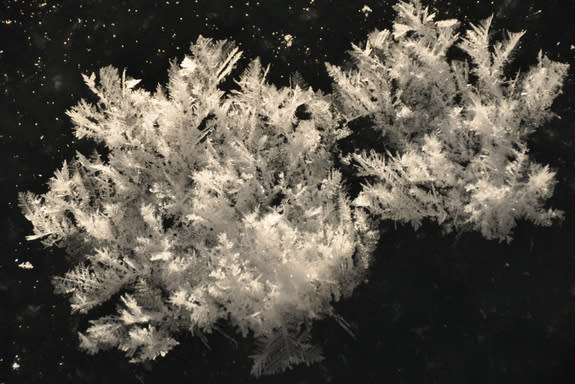The Arctic in a Pool: Simulator Grows Sea Ice
This winter, flowers bloomed in the northern Canadian city of Winnipeg. But not the verdant blooms that might come to mind; these were frost flowers.
The University of Manitoba opened a sea ice simulator last year to see how ice forms on the open water of the frigid poles, and how it affects the local climate and plant life.
The $1.5 million Canadian ($1.46 million USD) Sea-ice Environmental Research Facility's 30-foot-long (9 meters) pool — the centerpiece of the project — is where the researchers sprinkle salt, water and environmental contaminants, then watch how the sea ice grows.
The facility runs during the winter, when the outdoor temperature is below 28.9 Fahrenheit (minus 1.7 degrees Celsius), the temperature at which ice forms.
"The real beauty is we can add [chemical or biological] tracers to it and use the sensors to monitor it in real time," said Feiyue Wang, an environmental chemist who leads the facility.
"As an experimental scientist, I always like to do control experiments. What if we hold some variables constant? What if we change them? You can't do that in the Arctic," Wang told OurAmazingPlanet.
Ice experiments
Frost flowers are one of the types of ice they can grow at the facility. These structures form around salt on the surface of the ice, and host a wealth of microbes that can survive in harsh Arctic environments. Previous research found that they contain far more salt than the surrounding waters.
"If they can concentrate salt, they can concentrate other chemicals in seawater," Wang said, adding that pollutants would be among the chemicals.
The challenge is trying to track down these structures. In the isolated north, scientists rely on remote sensing from satellites to take their research vessel to the correct location. However, it's difficult to pick out the frost flowers from the surrounding ice. [10 Things You Need to Know About Arctic Sea Ice]
At the facility last year, the researchers watched frost flowers over three days using one particular band of radiation. Their goal was to figure out how to position the sensor to best see the flowers. A paper on the research, led by the University of Manitoba's Dustin Isleifson will be published in a future issue of the journal Transactions on Geoscience and Remote Sensing.
Future plans
More research papers are forthcoming on acidity in the sea ice environment, as well as how carbon is exchanged with the ice, which would help tease out the effects of climate change from carbon dioxide on the Arctic ocean environment.
Within the next few years, the researchers aim to enhance their "simulation" by taking a sheet of ice from the Arctic and laying it inside the pool to do controlled bacteria studies.
The researchers are also laying the groundwork for a facility expansion that would allow them to study oil spills in the sea ice environment. The first concrete step will be to obtain funding, which the researchers are working on now.
Follow Elizabeth Howell @howellspace, or LiveScience on Twitter @livescience. We're also on Facebook & Google+.
Copyright 2013 LiveScience, a TechMediaNetwork company. All rights reserved. This material may not be published, broadcast, rewritten or redistributed.





